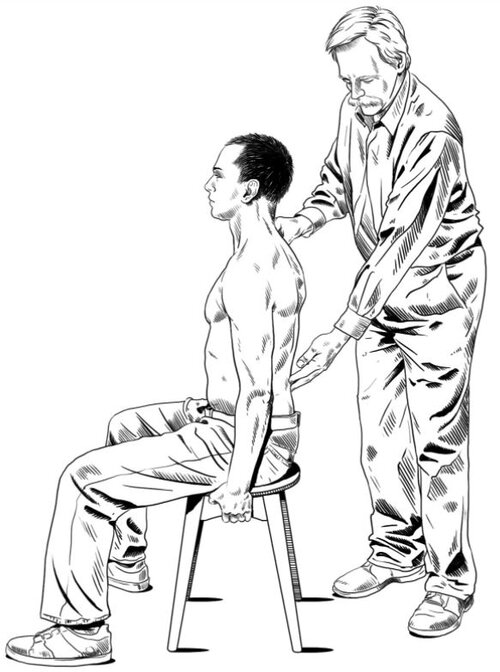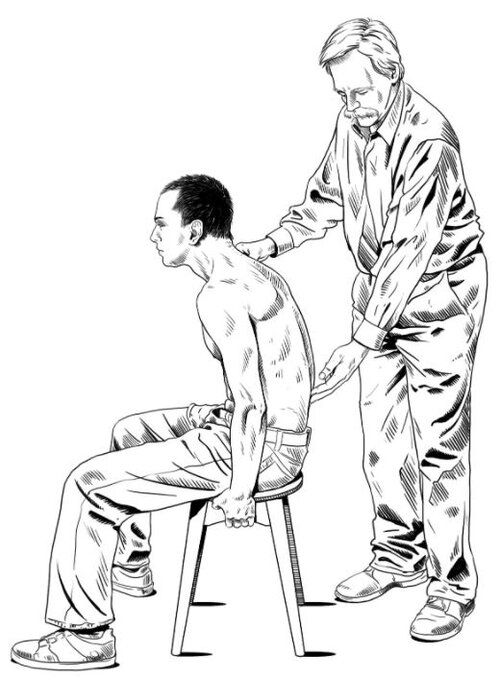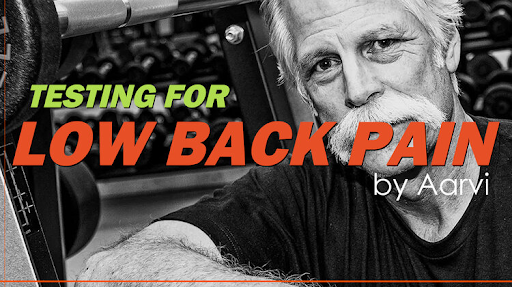How do I know if my back pain is serious?
Hi guys, Aarvi here.
As the great Dr. Stuart McGill, leading back professor in the world today states there is no such thing as non-specific back pain or chronic back pain.
There is always a cause.
Nearly always, the pain is worsened by specific motions, postures and loads, and yet may also be relieved with specific motions, postures and loads.
So once you establish these patterns you are one big step closer to curing your back pain. As most the time individuals will move in patterns that aggravate their back i.e. continually picking at their scab.
Watch this video below where we run through a few quick tests to see the extent of you low back pain and also answer some common questions that we get in the clinic.

What can a Doctor or Physio do for chronic back pain?
In all cases a typical 15-20 minutes appointments simply are not sufficient to diagnose back pain. The person has no guidance as to what is required to build a foundation for pain-free movement Dr. McGill describes.
Also getting passive treatments such as prescriptions for pain medication, or a modality such as ultrasound, without a plan to stop the cause itself rarely creates a long-term solution.
While medication may be a part of a broader approach, a thorough assessment of an individual’s specific pain triggers will identify a pain mechanism and guide a targeted treatment plan.
How do I know if my back is muscle or disc?
Your back is subjected to various strong forces throughout the day, such as from twisting, sudden jolts, or poor posture when sitting hunched over. Any of your spine’s many interconnected and overlapping structures are capable of becoming injured and producing back pain. Common anatomical causes of back pain include –
- Large muscles that support the spine
- Spinal nerves that exit the spinal canal and may go to the legs or elsewhere
- Facet joints that connect the vertebrae along the back of the spine
- Intervertebral discs that provide shock-absorption for the bones
Muscle pain tends to be unilateral and causes spasms around the affected area and is usually more localised. It is usually aggravated by certain movements i.e. sit to stand, walking.
Whereas disc pain is commonly aggravated by sitting down for too long and bending down to pick up objects. Commonly this is less localised and can cause referral down to lower limbs depending on which disc is irritated.
However back pain can commonly affect multiple structures at once therefore back pain has a wide range of scaling of pain and each is different and is case by case dependent. Therefore there is no one size fits all.
But what can be done?
You can establish Motions, postures or loads that exacerbate the back pain together with those that are tolerated can be identified through a series of simple diagnostic tests.
A simple test you can do at home to find the pain triggers according to Dr. Stuart McGill.
- The Sitting Compression Test
It is a simple test that can indicate how certain postures outside neutral can be exacerbating your pain. This will indicate positions to avoid completely until your pain settles and you can tolerate that posture pain free.
Start by sitting on a stool/chair with your arms by your side. Have a nice good posture with your spine in neutral. Pull the chair up (approximately 10kg) to add compression to the stacked spine.
- Next slouch and repeat the compressive load. This will reveal if posture and spine curvature affects the pain. Many clients will be pain-free in the upright, stacked posture while the slouched will be uncomfortable. This reaction shows that flexed spine positions must be reduced when under load to reduce the pain sensitivity.
- Repeat the same in an overarching position. If this causes pain then this will indicate a type of extension intolerance.


Summary of what each position can mean –
- Neutral pain = Compression intolerant – When contraction of muscles is too much for your body so avoid any heavy lifting.
- Stooped = Flexion intolerant – Avoid any bending movements (movements that bend the spine forwards).
- Overarching = Extension intolerant – Avoid any movements that overarch the back and typically you can tolerate lying on your stomach.
This can give you an idea what postures to avoid and what intolerance you have. If you work out movements that your spine can and can not tolerate, you have taken a big step towards a pain free low back.
Another Important component is learning how to brace properly and can be a vital component in rehabilitating your long history of low back pain. If this brace causes pain then you most likely have an compression intolerance.
Prone Lying Test
Find a bed or a spot on the floor and lie flat on your stomach. If this increases your symptoms then encourage you to stand up correctly (discussed below on how to stand up correctly from floor)
- You likely have an extension intolerance that makes lying flat on your stomach painful.
If this position is pain free, remain lying on your stomach for a few minutes. After, stand back up without letting your spine round (push up from your hands). If pain is reduced then we can assume your back pain is triggered when the spine is rounding.
With most disc related injuries this will be something that really calms the body and help reduce the pain.

The Abdominal Brace
Proper muscle function is important to support a robust and pain-free back. Without the surrounding muscles, the spine would be considered totally useless and would not be able to support the weight of the upper body.
Muscles are contracted in a coordinated manner that allows them to act similarly to guy wires, preventing the spine from buckling and giving way under high load levels.
By stiffening and stabilizing the torso, these muscles allow movement to be propelled through the arms and legs. This stress-free movement is only possible when there is a stiffened core and corresponding mobility at the shoulders and hips.
Stuart McGill describes this process very well in this video

So how do we brace?
Place your fingers on the side of your stomach roughly in line with your belly button. Try and gently contract your abdominal muscles. It is often helpful to imagine you are about to be hit in the stomach and you need to tense your abdominal muscles for protection.
If that does not work.
Do a cough and feel the side muscles contract and push into your fingers, that is what a brace should feel like. If you are still struggling to get that same contraction, try a cough and hold the brace, you can keep this method until you feel you have understood the way to brace without cough.
Now try to hold the abdominal contraction as you breathe in and out, because during the day you will not be holding your breath the whole day.
So when or how much to brace?
Well it depends because you fine tune it to the activities you are doing. So if you are just going for a walk or lunging down to pick something from the floor you will have a lighter brace and if you are picking something that is heavy you would go for a more maximal brace.
This sweet spot is governed by a set of movement principles and what you find comfortable.
Improving Basic Movement Patterns
This is probably going to the biggest game changer, if you can improve your basic movement patterns — so the way you sit, stand, walk, bend and pick items from the floor so any everyday movement we do multiple times a day.
The main goal is to try and keep a neutral spine as much as possible because a lot of back injuries occur due repeated microtrauma /stresses on the spine. This occurs when the back is repetitively moved out of neutral spine and if load is added the stresses become a lot higher.
Any kind of back pain will require this step as neutral spine the back is the most safest and when maintained in this position the back can actually start its healing process.
Check out the blog posts on –
https://www.prophysioplus.com.au/blogcontent/category/Stuart+McGill+Series
which contain the basic movement patterns you go through everyday
Hip hinge (Part 1)
Sit to Stand (Part 2)
Stand-lie (Part 3)
FYI: The best way to pick items from the floor is via lunging down and then picking the items from the side keeping the spine neutral.
Building Stability In Your Spine
Just think of a symphony orchestra team where each member plays their instrument in a united manner with changes in tempo and volume, our body must do the same as they have to coordinate each and every muscle and joint to create a purposeful and sound movement.
The muscles that surround our spine are considered the “core” of our body. It is composed of the abdominal muscles on your front and sides, the erector muscles of the back and even the larger muscles that span multiple joints (like the lats and psoas muscles). It may surprise you that the glutes are also an important part of the ‘core. Each and every one of these muscles must work together in order to enhance the stability of the spine.

But in order to enhance the quality of stiffness, one must train the core differently. This comes through an approach of using isometric exercises.
An ‘isometric’ describes when a muscle or group of muscles are activated and contracted but there is no change in the joints they cross. For example, during a side plank the lateral oblique and quadratus lumborum (QL) muscles are very active yet the spine and hips remain still and do not move.

Research has found that isometric exercises for low back pain are far superior when compared to dynamic strengthening exercises in enhancing spinal stiffness and stability because it helps in developing muscular endurance.
The 3 exercises to start off with are the McGill big 3″:
- Curl-up
- Side plank
- Bird-dog
Check out my video as I go through all these exercises in more detail.
What Is The Rep Scheme?
Dr. McGill advocates for using a descending pyramid rep scheme with 10-second isometric holds in order to enhance stability without fatiguing and overworking the body.
An example program would be to perform five reps, then three, and finally one to end (each with an 8-10 second hold). Rest between each set for 20-30 second.
Final Thoughts
So there you have it, hope these tips can help with your low back pain or even prevent any low back injuries to occur. I do all these myself and must say it has been a game changer since starting these exercises.

